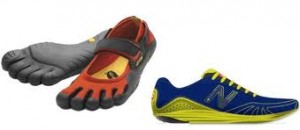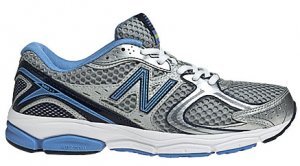Traditional Running Shoes VS Minimalist Running Shoes
 The theory behind minimalist running shoes is the less weight on the foot, the less energy you expend, and the faster, and longer, you will be able to run.
The theory behind minimalist running shoes is the less weight on the foot, the less energy you expend, and the faster, and longer, you will be able to run.
Minimalist running shoes promote a forefoot-first stride which lessens the impact of the heel strike and is bio-mechanically more natural which minimizes repetitive-motion injuries.
This is achieved by a wider and roomier toebox, (articulated toes) a minimal design that uses less material between the runner and the ground and a zero-drop heel.
 Traditional running shoes, with a heel-first stride, increases the impact of heel strike, which in the long-term can lead to injury or joint pain.
Traditional running shoes, with a heel-first stride, increases the impact of heel strike, which in the long-term can lead to injury or joint pain.
Manufacturers of traditional, running shoes claim stabilization and cushioning technologies can solve most personal bio-mechanical issues such as running on hard services like concrete, leg-length discrepancies, and over-pronation.
Switching from a traditional running shoe to a minimalist running shoe needs to be done very gradually. Using a forefoot-first stride will require muscle strength and flexibility in your foot, ankle, and quads. Due to a zero-drop heel your stride will be noticeably shorter. Changing too quickly from a traditional running shoe to a minimalist running shoe will increase your risk of injury, so you will need to incorporate training time.
During your training period, you will need to dramatically decrease your daily mileage, avoiding steep hills and minimize running on hard surfaces. You may want to consider starting with a runner that has a 4-8mm heel drop to help with the transition from traditional runners to zero-drop runners.
The drop refers to the difference in height of the shoe from the heel to the toe. Traditional running shoes raise the heel anywhere from 15-25mm off the ground, with the toe of the runner measuring 8-15mm. This difference creates a forward leaning slope which encourages heel-toe gait. The theory is that a smaller drop creates a more natural gait.
Deciding to switch to a minimalist runner? Here are a few things to consider…
~ Don’t buy a shoe that you’re not ready for. Perhaps a drop of is 4 or 8mm is a better place to start than a zero-drop.
~Don’t buy the wrong size, make sure it fits properly.
~Don’t buy the wrong type of shoe or buy a shoe because of the way it looks. Minimalist running shoes are designed for different needs. If you’re going to be running trails, buy a minimalist trail running shoe. If you’re going to be running on the street, go for a minimalist road shoe.
~ Don’t wear a new pair of running shoes with a race coming up. Remember that transitioning takes time.
Choosing which style of runner is best for you, comes down to which runner fits well, and works well for your personal stride, foot shape, bio-mechanical needs and the type of activity you will be engaging in.


Leave a Reply
Want to join the discussion?Feel free to contribute!